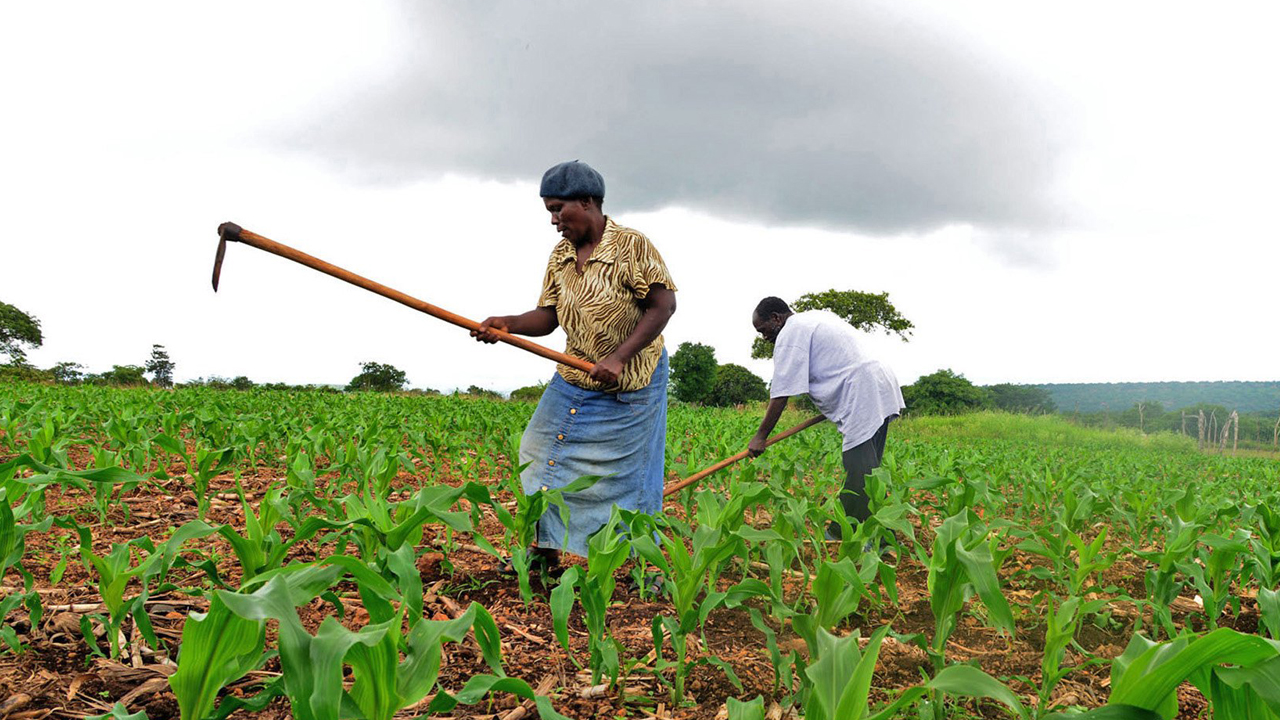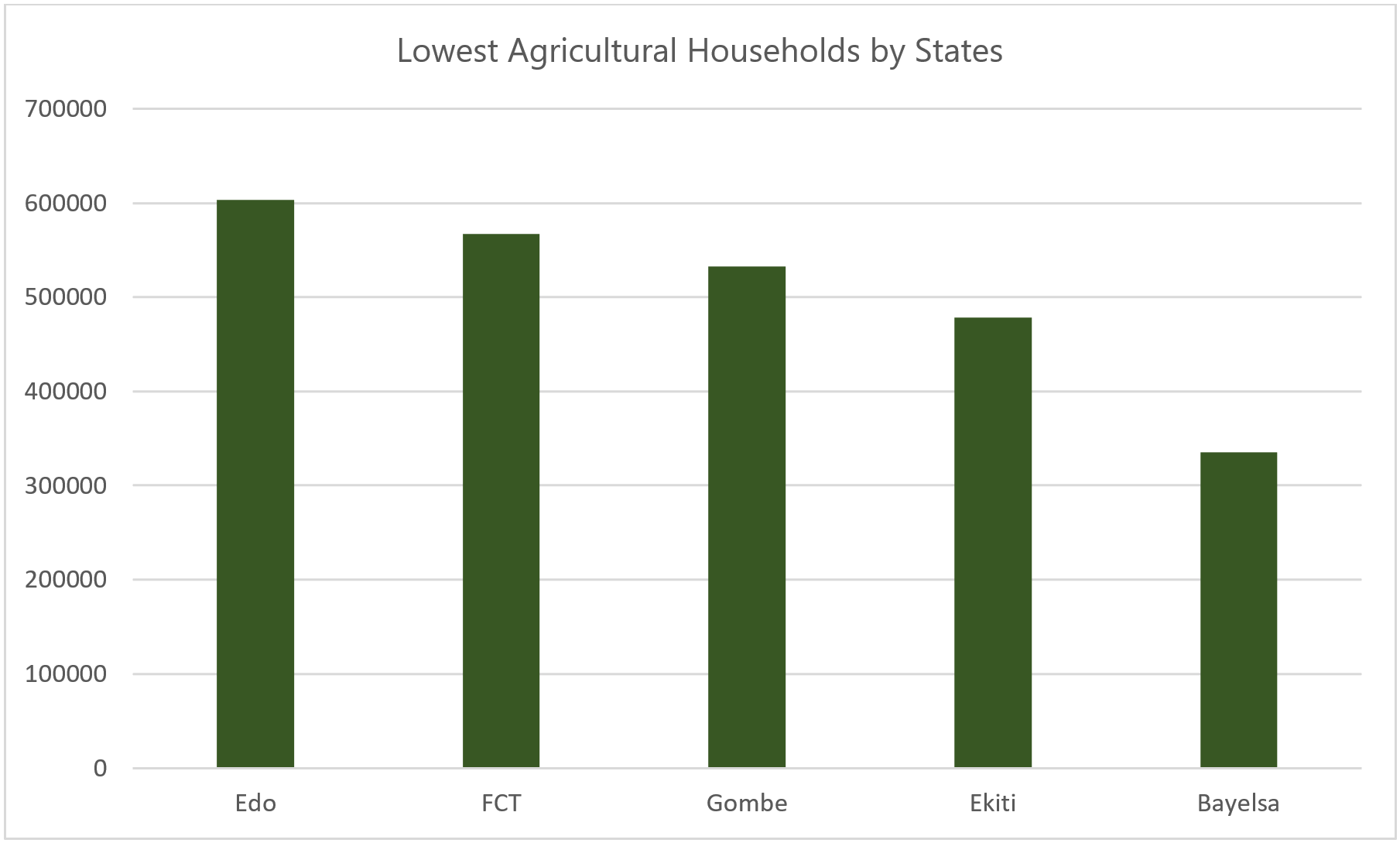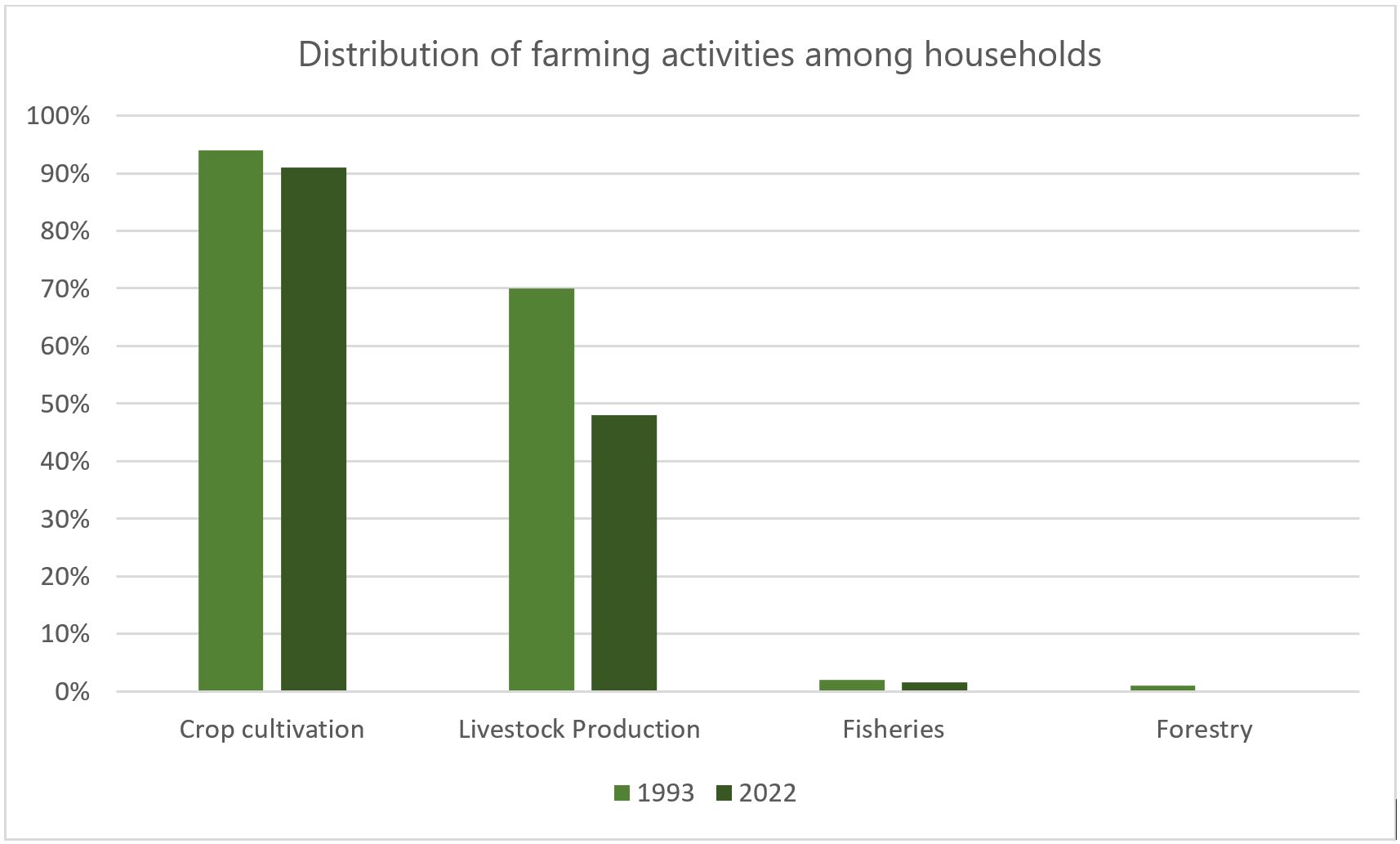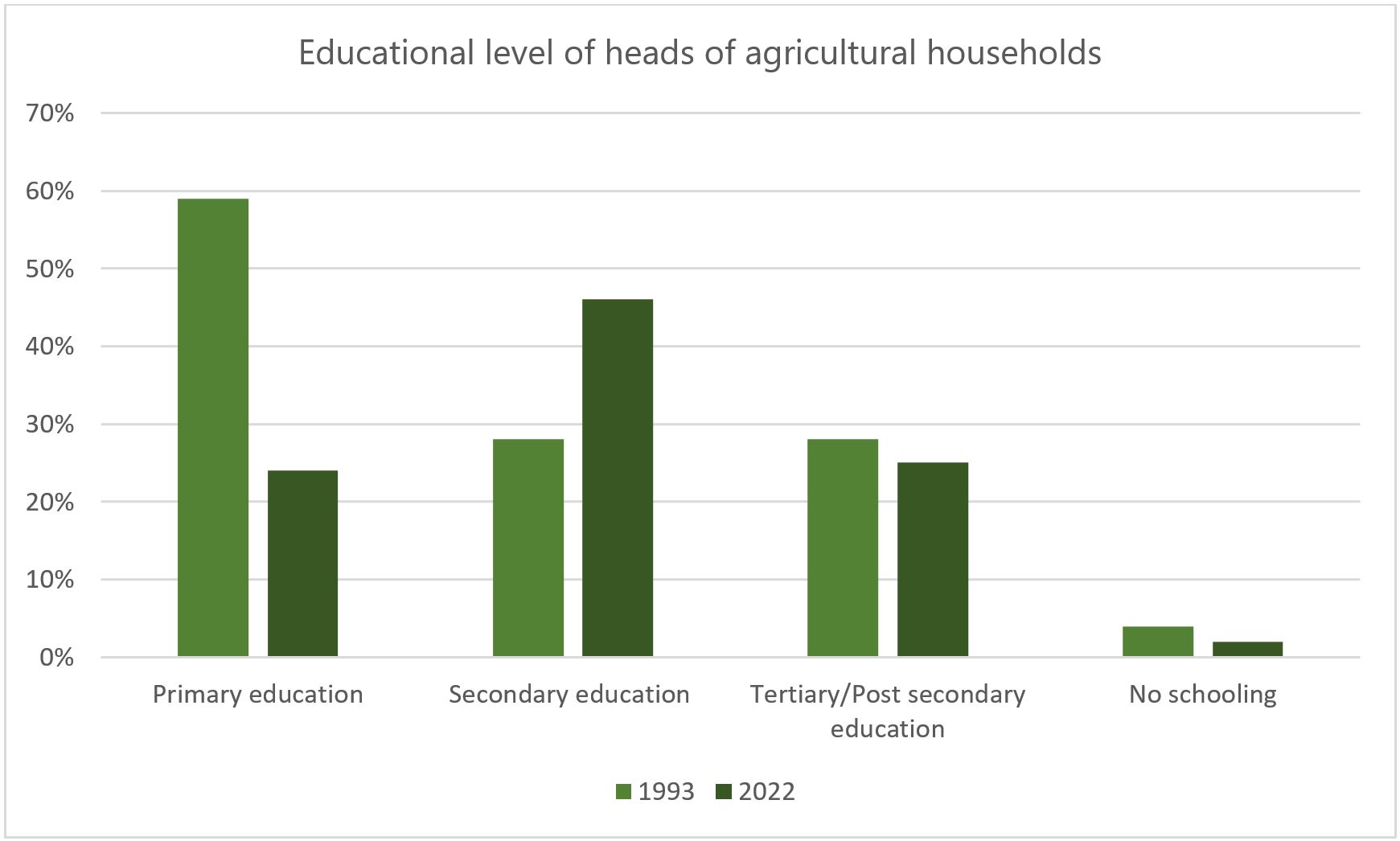By Ayobami Ayorinde | On Monday, the National Bureau of Statistics (NBS) in collaboration with the Federal Ministry of Agriculture and Food Security (FMAS) and other key stakeholders released the National Agricultural Sample Census (NASC) for 2022. This is the first census report detailing the state of agriculture in the country since the last one released in 1993.
In the light of Nigeria’s current food security challenge, this report provides data on resource management, labour dynamics, and diverse agricultural activities at the household level. In this report, we will highlight some of the key issues/findings from the census report.
Insight 1: 40.2 million Nigerian Households Practice Agriculture
According to the census report, Nigeria has 40.2 million agricultural households. The NBS defines an agricultural household as one where at least one member engages in agricultural activities but this does not mean that all members of the household are involved in agriculture. The number of households engaged in agriculture reinforces the significance of agriculture to food production and consumption, employment and productivity in the country. According to the report, Kano State leads the pack with 2.4 million agricultural households, followed by Kaduna State with 2 million households. Bayelsa State has the lowest at 335,000 households followed by Ekiti state at 478,000 households. All the top five states are from the north, while most of the lowest five states are from the south.
Insight 2: 91% of Agricultural Households Cultivate Crops
Crop cultivation dominates activities among agricultural households, with 91% engaging in it. While only 35% focus on crop cultivation exclusively, others practice mixed farming, combining crop cultivation with livestock and poultry. Of the 91% households that engage in crop production, 95% of them cultivate cereals, 67% cultivate oilseed crops, and 62% do root/tuber crops. The cereals most favoured by households are: maize (80%), guinea corn (40%), and rice (37%); while households reported cultivating cassava (53%), yam (40%), and cocoyam (24%) within the category of root/tuber crops. Notably, female-headed households are more involved in fruit and nut crop cultivation compared to other types of crops. The high percentage of agricultural households engaged in crop cultivation, particularly cereals, oilseeds, and root and tuber crops suggests that these crops are crucial for consumption and household income generation in Nigeria. It also reflects its contribution to economic growth, as crop production accounted for 90.4% of agriculture’s GDP as at 2022.
Insight 3: Livestock Ownership Plunged from 70% to 48%
Livestock ownership in Nigerian households has declined since 1993, with 48% owning livestock in 2022 compared to 70% previously in 1993. This decline suggests a shift towards other agricultural practices or a reliance on commercially produced meat and dairy products. It may also be due to challenges in livestock production such as veterinary services, high costs of feed, and difficulty in accessing credit. Goats are the most commonly raised livestock (85%), followed by sheep (46%) and cattle (33%), with Jigawa (84%), Bauchi (80%), and Gombe (74%) states reporting the highest levels of livestock production. Meanwhile chicken is the most commonly raised poultry, with 95% of households raising them. Interestingly, Rivers State stands out with the highest average herd sizes for cattle (34.7), goats (16.7), and sheep (22.4) among households and shows a surprising potential for livestock ownership.
Insight 4: Household Land Area is Low Compared to Other Countries
On average, Nigerian households cultivate approximately 0.5 acres[1] of land with Ebonyi and Benue states recording the highest number at 0.6 acres per household, and Lagos State the lowest at 0.3 acres. Despite this, only 23% of crop-producing households manage between 0.8 to 1.5 acres, with male-headed households averaging 0.6 acres and female-headed households averaging 0.5 acres. The average farm size is low when compared to other African countries. According to the FAO[2], the national average of farm size in Nigeria is 0.85 hectares, which compares unfavourably with 1.4 hectares for Ethiopia, 2.56 hectares for Ghana, and 4.57 hectares in Niger. This low farm size highlights the constraints on production and yields, and shows the predominance of subsistence agriculture in Nigeria.
Insight 5: High Disparity in Irrigation Farming across Nigerian
In Nigerian States communities surveyed, 92% rely on rain-fed agriculture while 27% combine irrigation with reliance on rainfall. Irrigation farming is prominent in Kebbi and Kaduna states (both in the North West), practiced by over 60% of the communities whereas, only 3% of communities in Imo use irrigation farming. Additionally, less than 2% reported infrastructural development in irrigation, highlighting the critical need for significant investments in irrigation systems to support food production all year round amongst households, and improve food availability and security in the country.
Insight 6: Milk Processing Facilities Available in less than 2% of Agricultural Communities
89% of communities in the North West practice cattle rearing but only less than 3% have milk processing and conservation facilities. This is slightly higher than the 2% nationwide. This shows a significant gap in the dairy value chain that limits the ability of farmers to process and preserve milk, leading to low productivity and high reliance on imports. Nigeria’s annual average milk production per cow is 213 litres, which is less than one tenth of the global average at 2,200 litres[3].
This low dairy productivity, contributes to Nigeria's status as a net importer of milk and dairy products, with national production covering only 40% of domestic demand[4]. While the majority of Nigerian cattle are indigenous breeds used primarily for meat, with only 11.5% of the herd dedicated to dairy production[5], the government can play a crucial role in bridging the infrastructure gap by investing in the establishment of milk processing centres and supporting the development of the dairy industry, which could help increase domestic milk production, reduce reliance on imports, and improve the livelihoods of cattle-rearing communities.
Insight 7: High Literacy Rate Amongst Farmers Can Boost Agricultural Productivity
Surprisingly, the census reports a high literacy rate among agricultural household heads with 95% of them having completed primary education or higher. This signals a huge potential for good agricultural practices, knowledge use, and adoption of new technologies amongst farmers if well harnessed.
With extension services accessible in only 55% of agricultural communities, an increased availability of extension officers will provide an opportunity for policymakers and agricultural development programmes to effectively target and support the adoption of innovative and sustainable farming practices, which could have a significant impact on the overall productivity and resilience of the agricultural sector in Nigeria.
Insight 8: High Cost of Land Limits Agricultural Productivity
From the report, the median cost of purchasing one acre of land with formal rights in Nigeria is N550,000, varying significantly across states from N8 million in Lagos to N150,000 in Borno. This highlights that factors such as location, infrastructure, and economic development play a crucial role in determining land costs, which could impact the accessibility and affordability of land for agricultural activities. 33% of communities lease their land for a fixed price or percentage of the harvest as the report shows that renting one acre without a sharecropping agreement averages N20,000 with higher rent costs in urban areas compared to rural ones. The availability of land renting indicates that it might be a more accessible way for some to acquire land for agricultural purposes considering the high cost of purchasing land. In addition, despite 82% of communities having property rights, 38% have operated without formal land title documents for over a decade with some communities either exploiting family or community land. This shows a prevalence of informal land ownership practices that may pose challenges for obtaining credit or securing investments.
Insight 9: Only 7% of Agricultural Communities Have Access to Bank Credit
Formal credit access to Nigerian farmers has significantly declined with only 7% of communities citing banks and microcredits as their primary source compared to 90% of holders in 1993. The low availability of bank loans and the high collateral requirements in many states suggest that there are significant barriers to accessing formal credit for agricultural activities, particularly for smallholder farmers and those living in rural areas. 24% of communities access credit through cooperatives, where collateral requirements are seen as less stringent compared to banks. This is higher than the previous value of 10% in 1993. The higher availability of credit from cooperatives compared to banks, and the less demanding collateral requirements, indicate that community-based financial institutions like cooperatives currently play a crucial role in supporting agricultural activities and may be more responsive to the needs of local communities.
Notably, 92% of those who reported availability of credit in their communities confirmed that loans are available to women. This shows that there is a growing recognition of the importance of supporting women's participation in agricultural activities and the need to ensure equal access to credit.
Insight 10: Child Labour Remains Prevalent in Agriculture in Nigeria
The report shows that child labour in agriculture is more prevalent in northern states such as Kaduna (71%) compared to southern states like Lagos (3%), with communities noting that children are mainly used by male farmers for fertilizer application and weeding. The higher prevalence of child labour in agriculture in northern states compared to southern states suggests the regional differences in cultural practices, economic conditions, and access to education that contribute to the use of child labor in agricultural activities. Male and female labourers are paid an average of N2000 per day, while children earn around N1000. Though child labour is often seen as a cost-effective way to meet labour demands in agriculture, it has negative implication for the health, education, and development of the affected children, and by extension of the country.
Conclusion
In this brief, we have outlined key findings from the National Agricultural Sample Census report. Our policy recommendations for the government and other stakeholders include: investing in irrigation infrastructure in agricultural communities, facilitating improved access to credit, enhancing agricultural extension services to promote knowledge use and transfer, addressing child labour in agriculture, tackling land tenure challenges and enhancing land accessibility, and bridging the processing gap in the dairy value chain. It is also recommended that the NBS, FMAS, and other stakeholders establish a regular agricultural census cycle (every 5-10 years) in line with standards set by the FAO and the United Nations so as to inform better policy decisions, track progress, and measure the impact of interventions in the agricultural sector.
The National Agricultural Sample Census 2022 can be accessed here:
https://nigerianstat.gov.ng/elibrary/read/1241525
[1] Conversion used was 1 acre= 6 plots
[2] https://www.fao.org/family-farming/data-sources/dataportrait/farm-size/en/
[3] https://www.ciwf.org.uk/media/5235182/Statistics-Dairy-cows.pdf
[4] Makun, H. J. (2018, April). Dairy production systems in Nigeria. In Presentation delivered at the Technical meeting of Africa Sustainable Livestock (Vol. 2050)
[5] https://www.asokoinsight.com/content/market-insights/nigeria-dairy-industry











